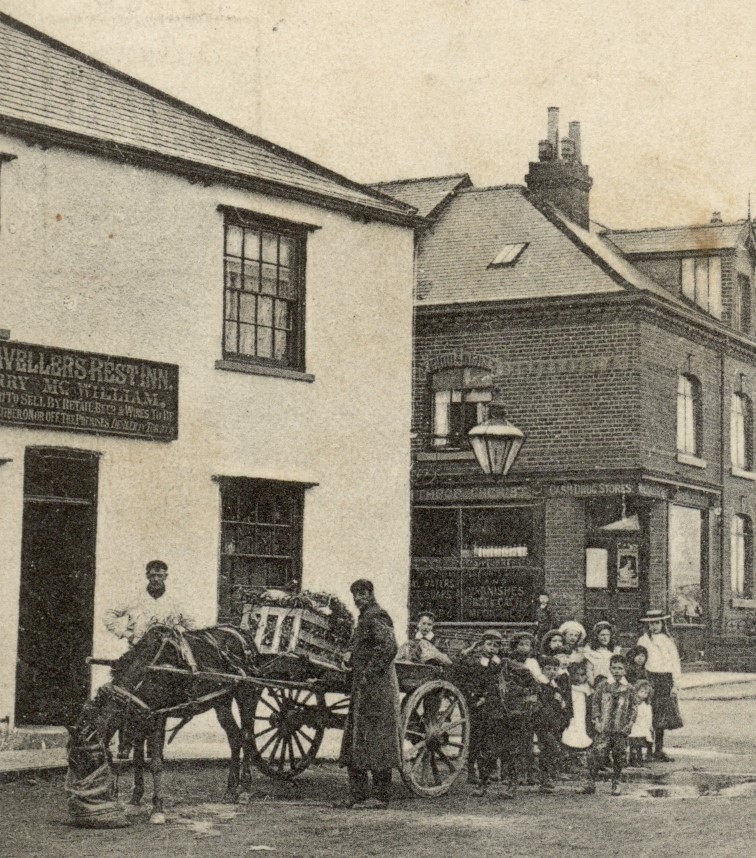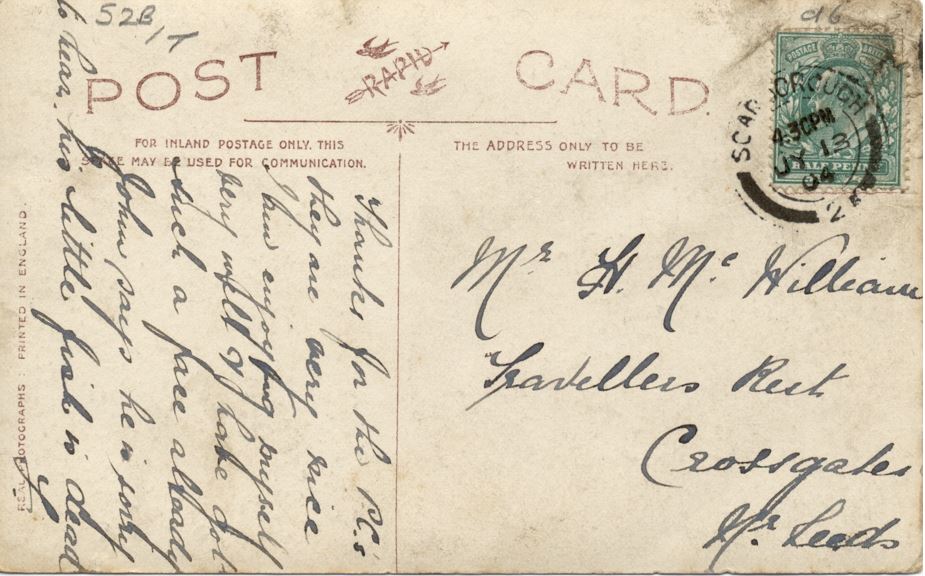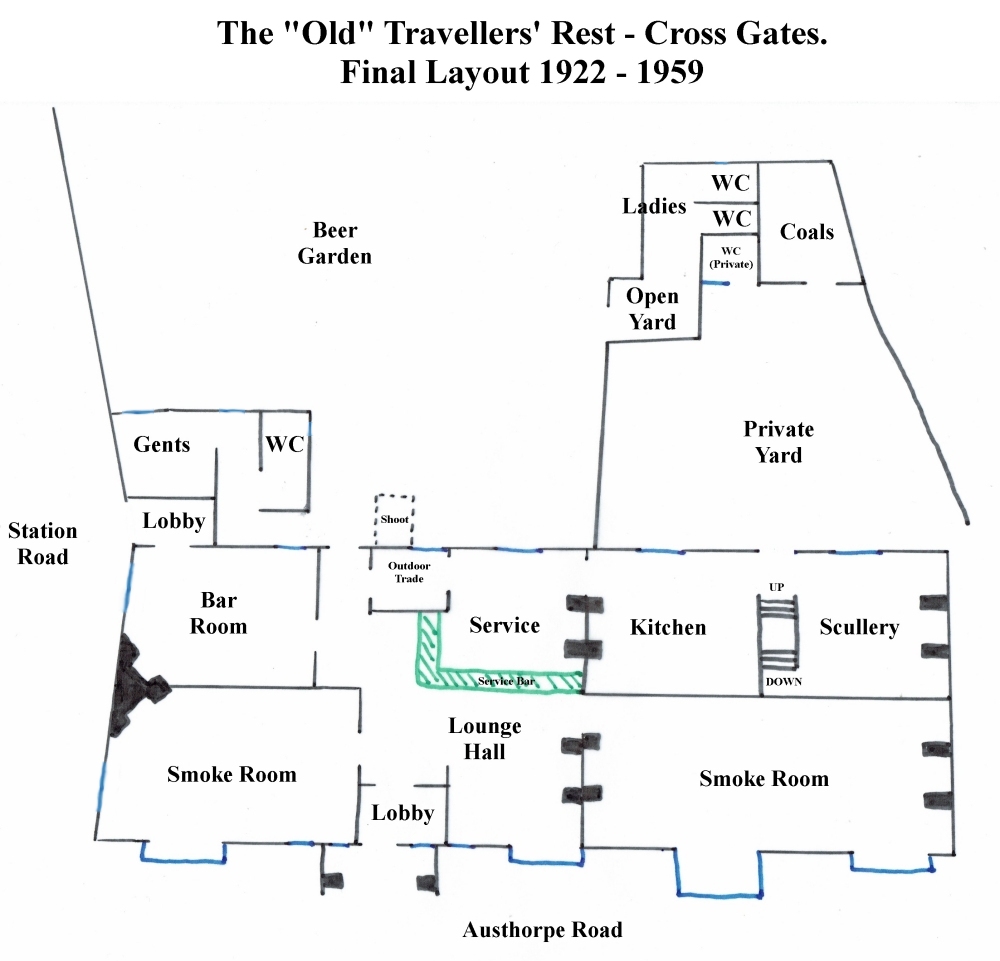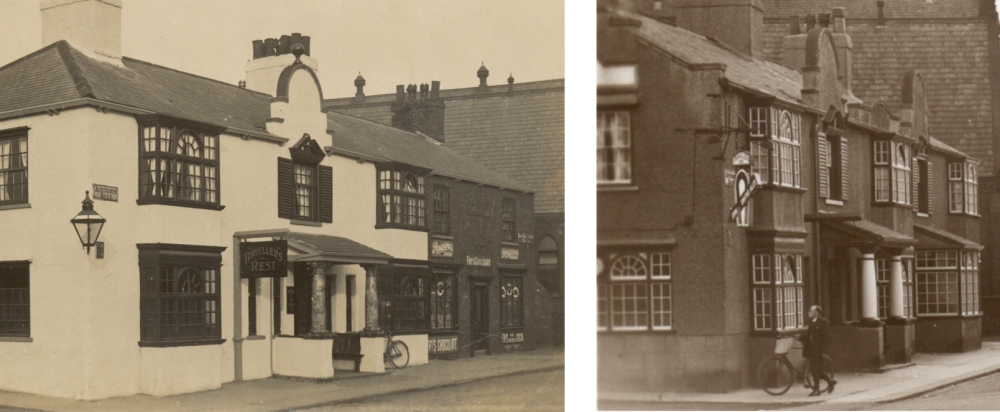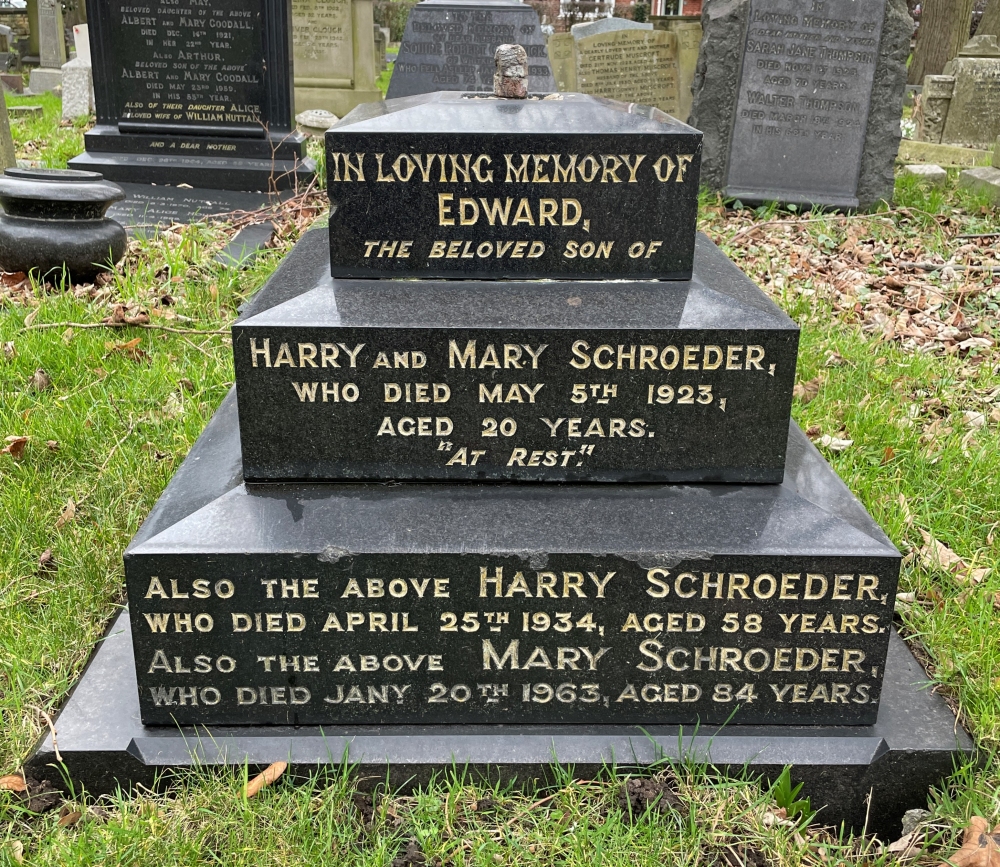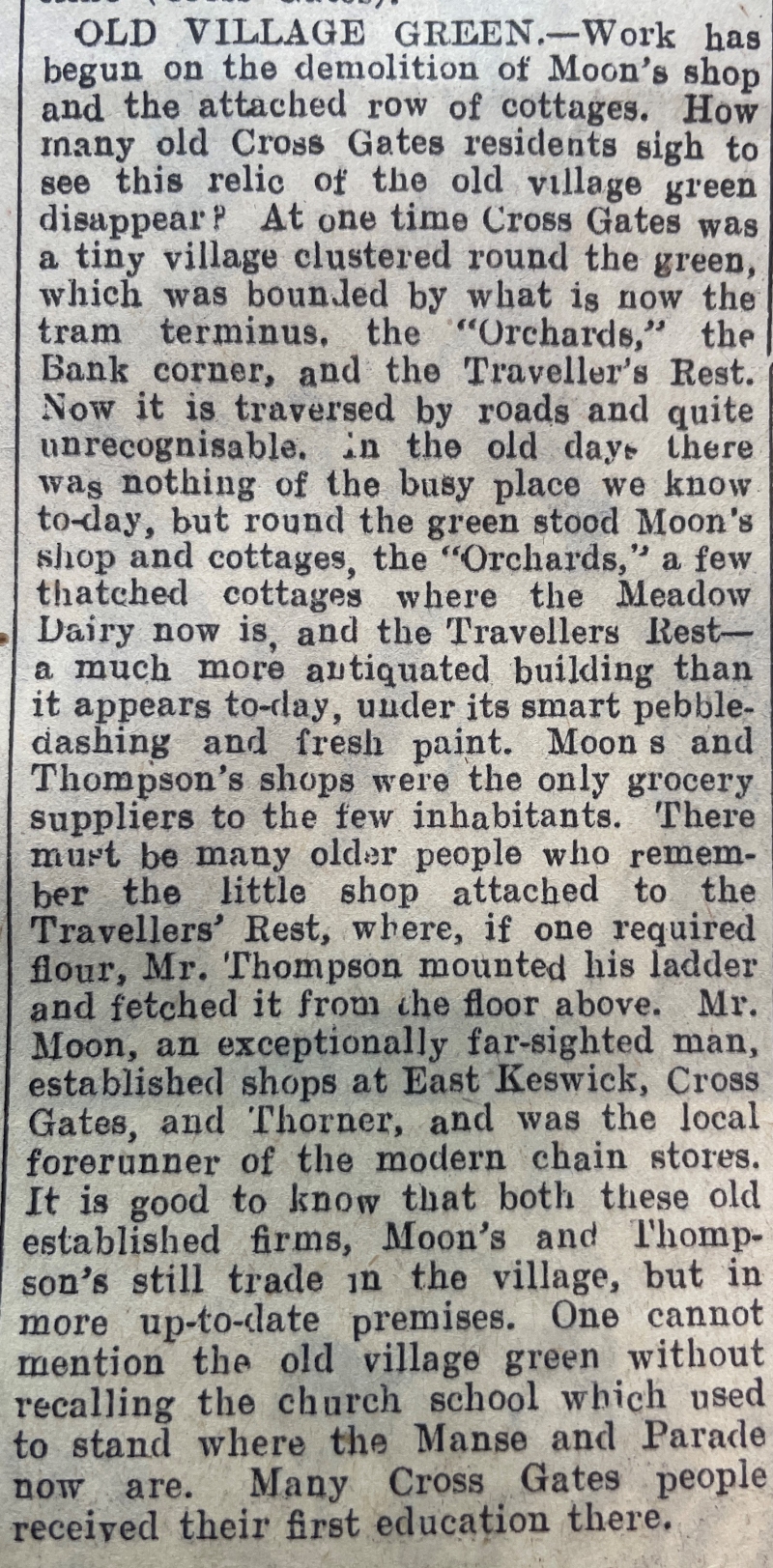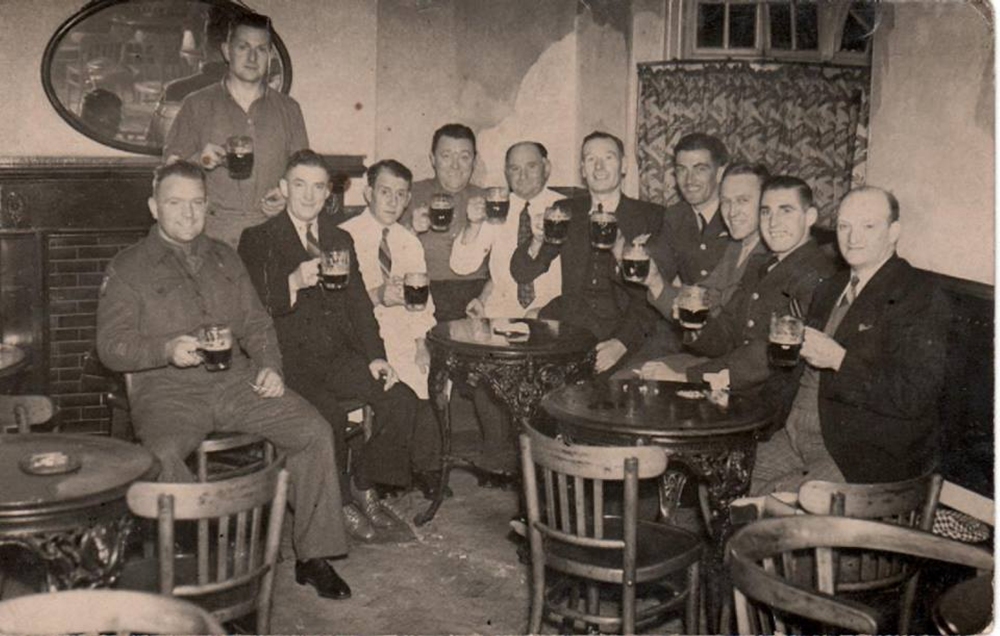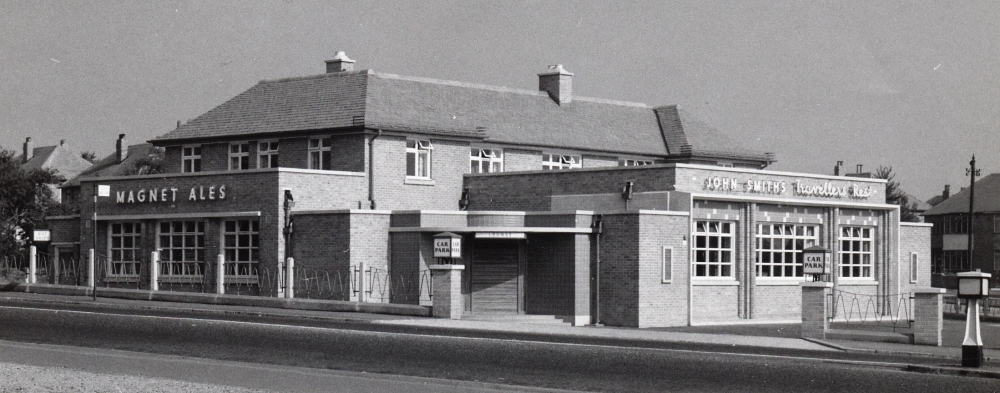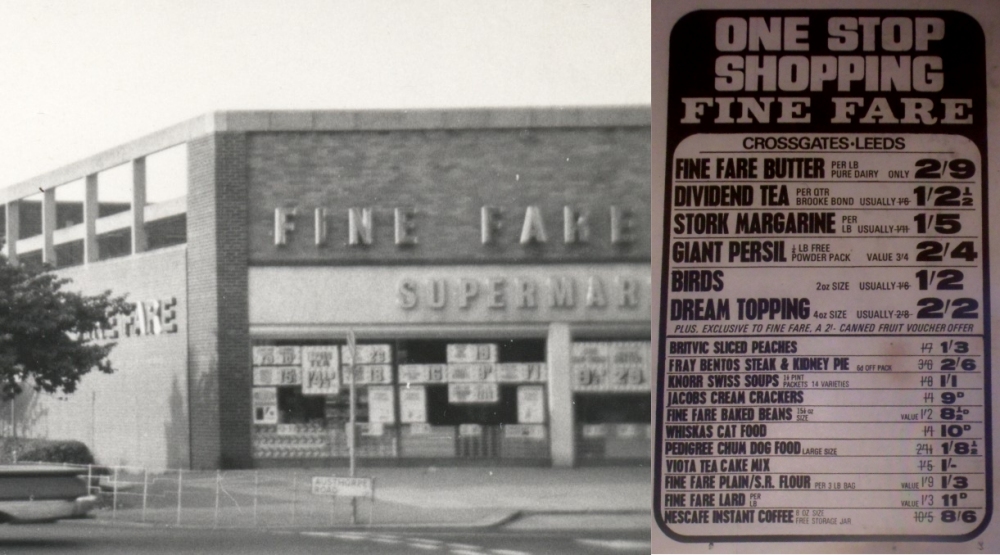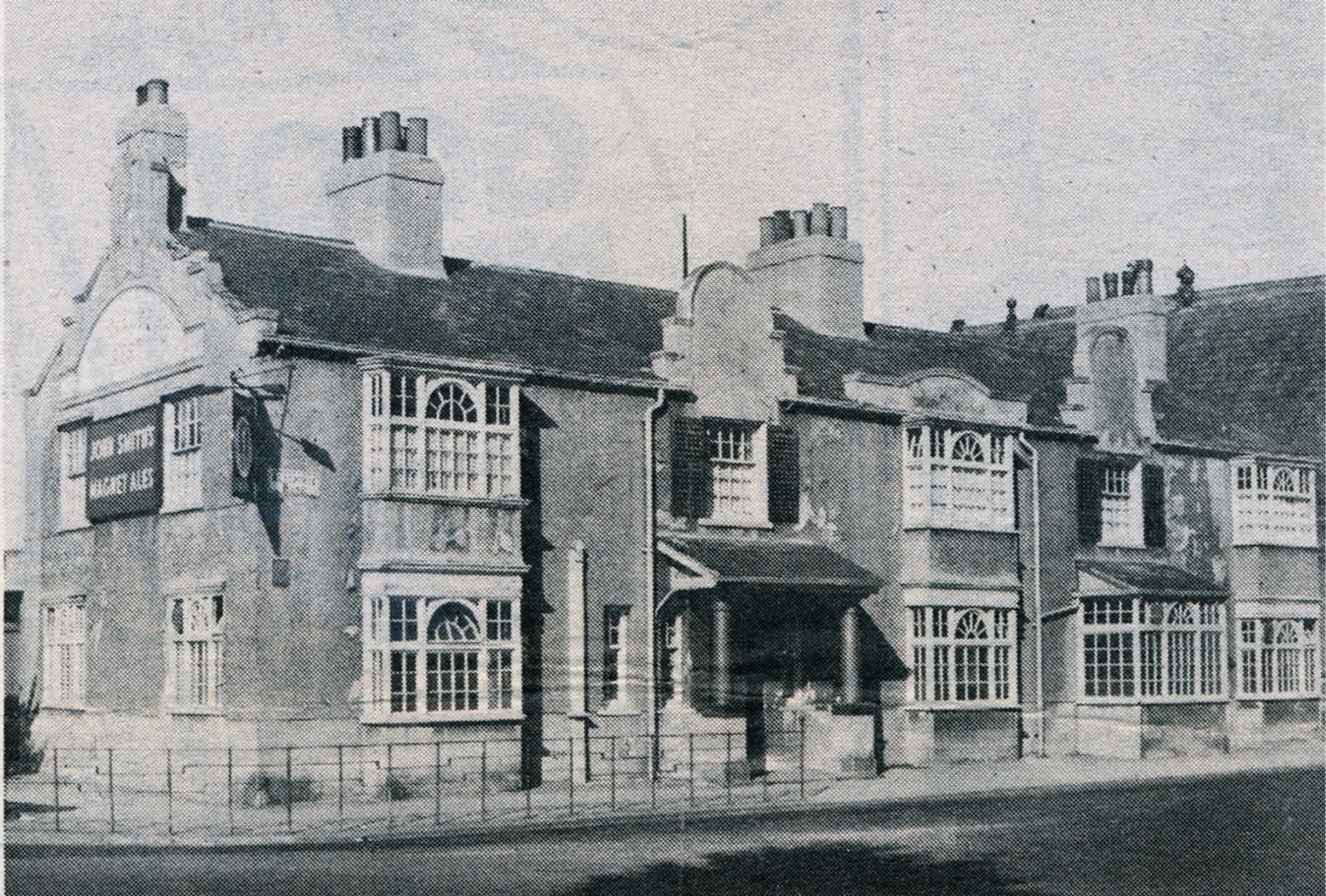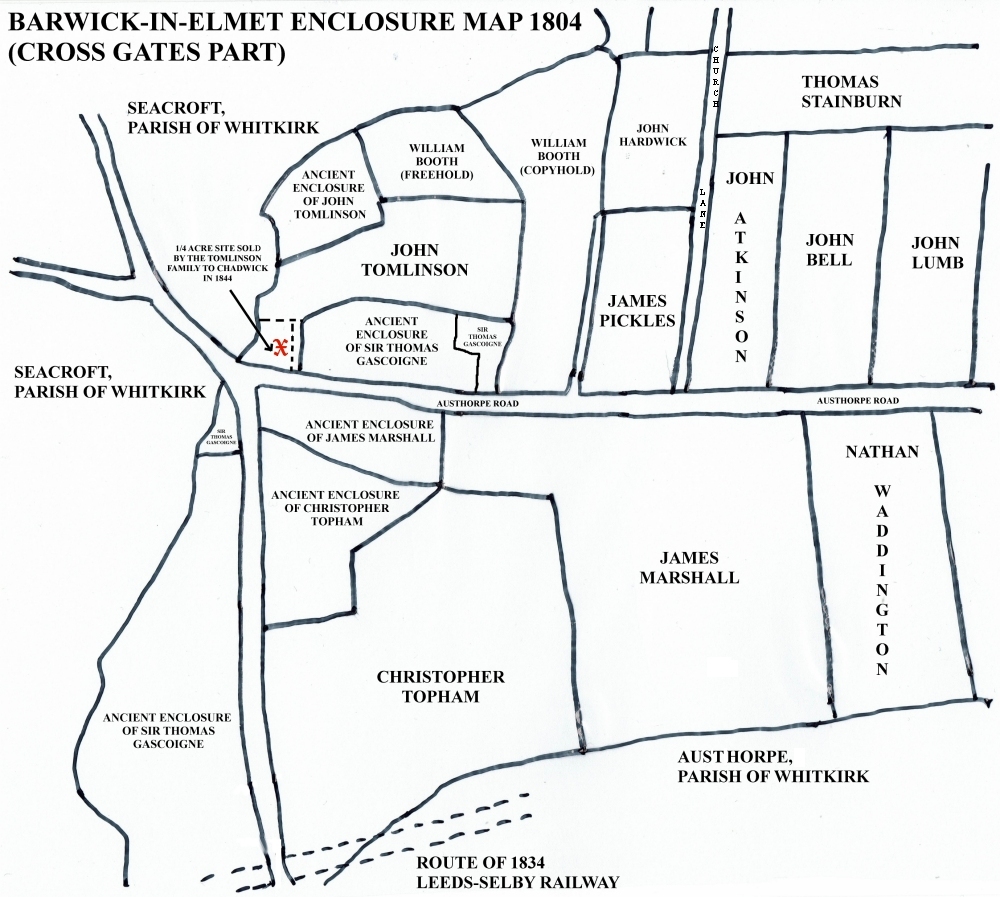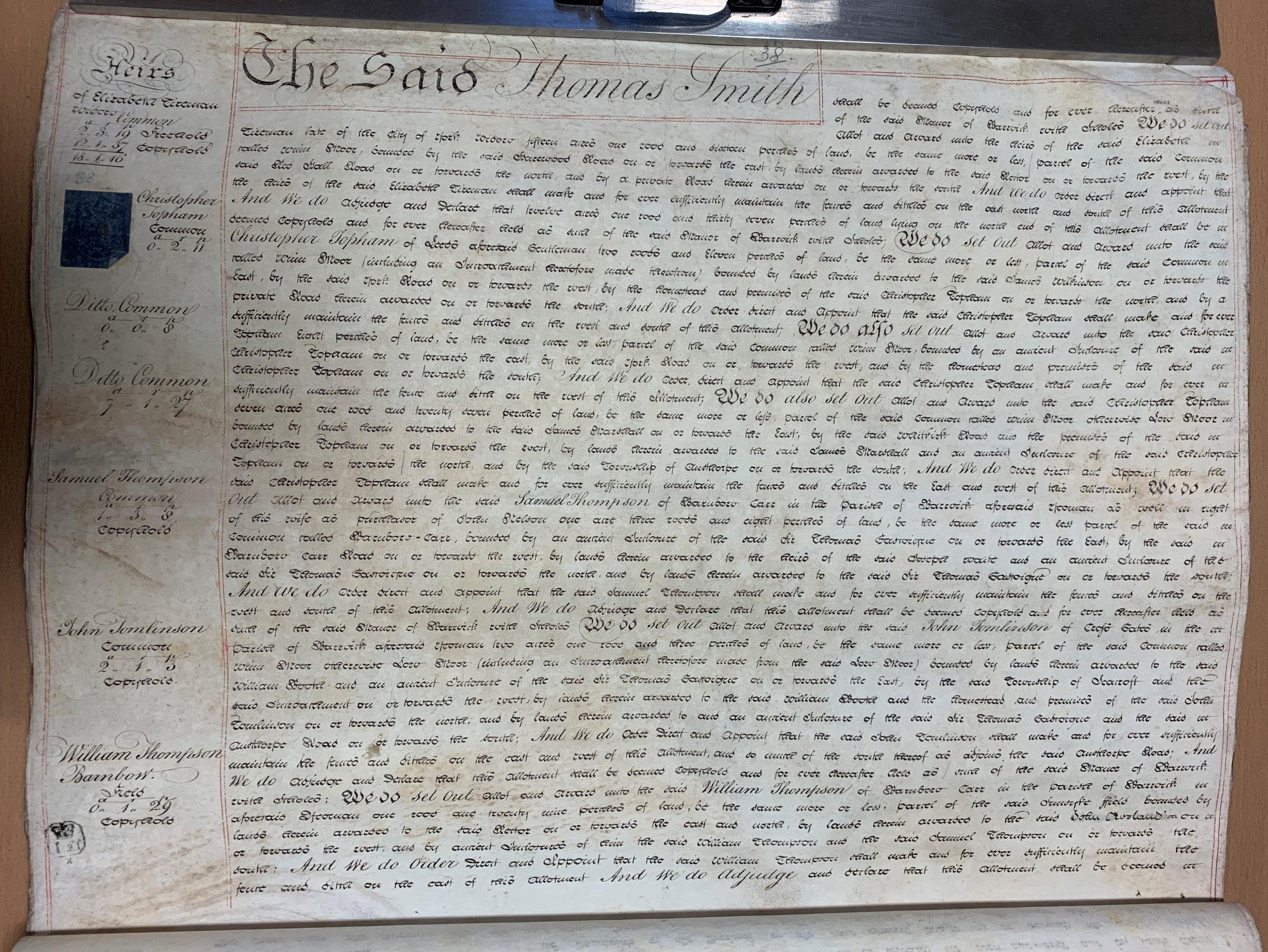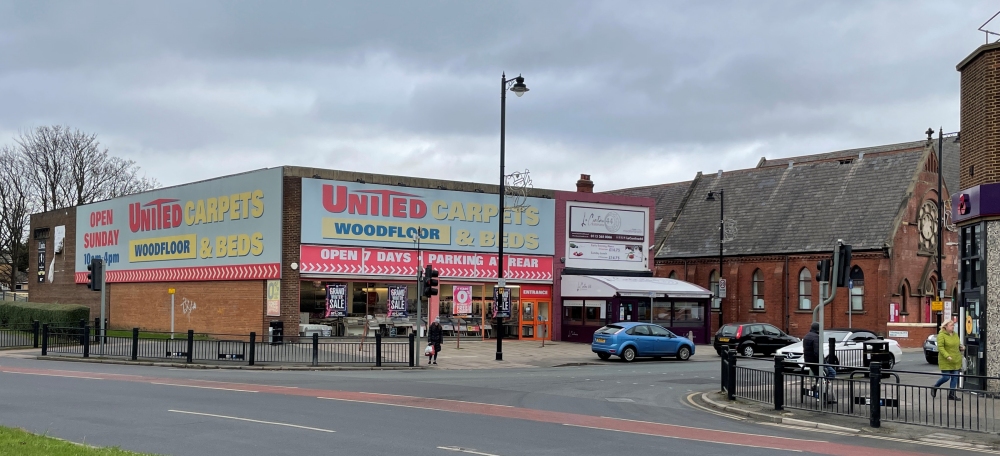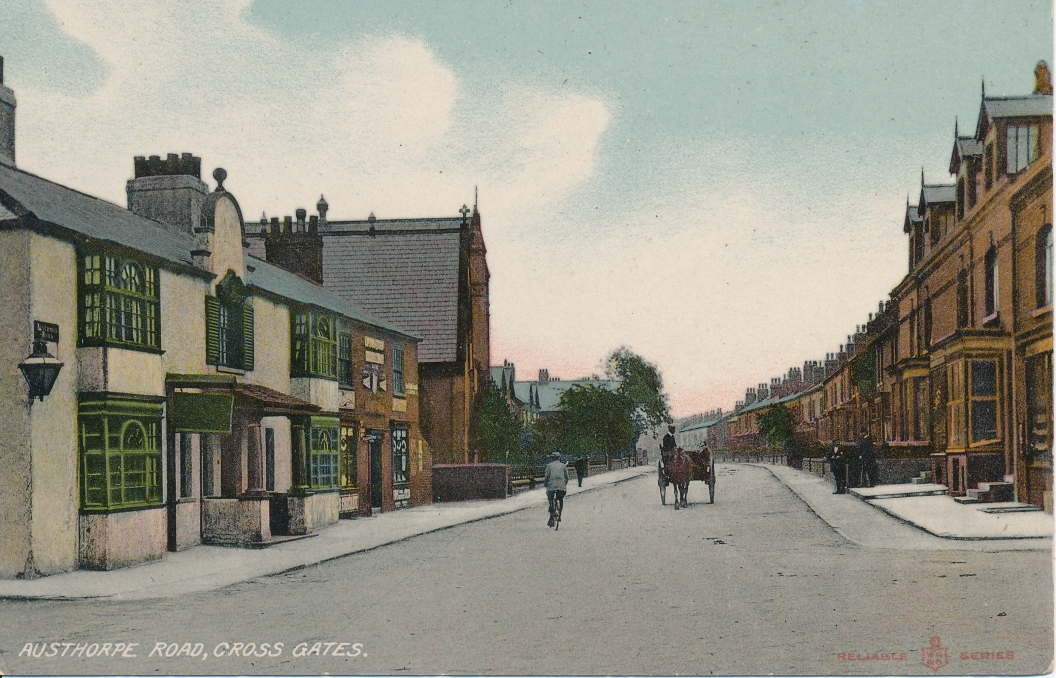 View along Austhorpe Road from Station Road c1910 - "Old" Travellers' Rest on the left. The "Old" Travellers' Rest public house at Cross Gates, stood on the north side of Austhorpe Road at the junction with Station Road just within the boundary of the ancient Parish of Barwick-in-Elmet. Its story begins on the 29th January 1844 when James Tomlinson, a farmer of Cross Gates, sold ¼ acre of land from the southern part of his farm, previously part of the wastes and commons of Barwick-in-Elmet, to William Chadwick, the local coal agent, and his wife Elizabeth for £30. (See the appendix for details of the history of the plot prior to 1844) Cross Gates was then a mining village, close to the northern edge of the vast Yorkshire coalfields, it was at the intersection of the ancient Parishes of Barwick-in-Elmet and Whitkirk. Piecemeal, small scale coal mining in the district had gone on for 100s of years but during the first half of the nineteenth century there was a massive expansion. This was due to the insatiable need for coal created by the industrial revolution, the enclosure of much local common land in 1804, the improvement in water pumping technology allowing deeper coal seams to be exploited and the coming of the railway to Cross Gates in 1834. Many pits were sunk in the Manstons, Marshalls, Bryans, Sandbeds and elsewhere locally. The small hamlet, which had consisted of a handful of cottages turned into a village. To service the pits and workforce, houses and associated infrastructure were constructed and around the late 1840s or early 1850s William Chadwick and his son Isaac built a row of brick cottages on their ¼ acre plot on Austhorpe Road. Isaac had married Ann Backhouse at Barwick-in-Elmet, All Saints Church, in 1840 and she was the daughter of George Backhouse, a Cross Gates builder, who was likely involved in the construction. It contained at least 5 dwellings and a grocers' shop which was run by William's daughter Elizabeth (Betty) Taylor and son-in-law Jonathan Taylor. 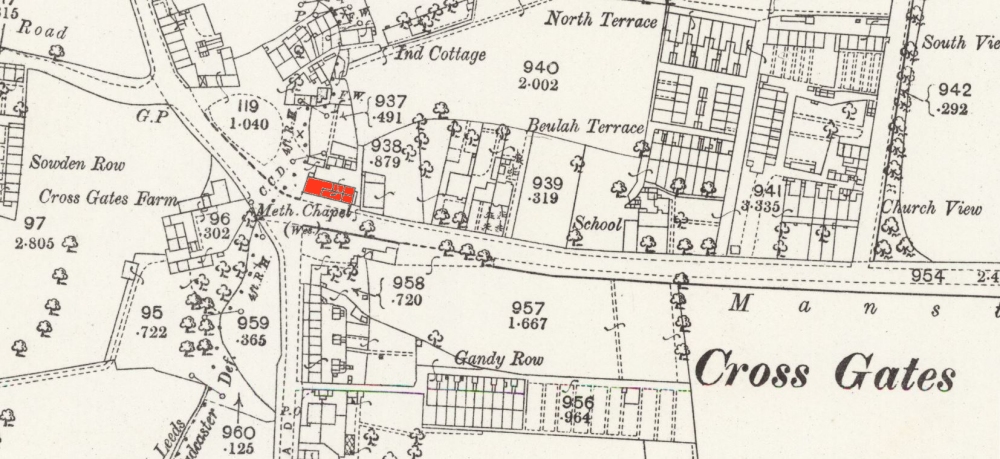 1891 map showing the premises on Austhorpe Road built by William Chadwick. William Chadwick, working then as a colliery steward, died in December 1857 aged 72 followed by his wife Elizabeth in February 1859 and the Cross Gates property passed at the Barwick and Scholes Manorial Court held on the 17th October 1861 to his eldest son and heir Isaac Chadwick, a colliery manager. On the 10th July 1859 Jonathan Taylor also died leaving Betty a widow with at least 6 children under the age of 18. She continued to run the grocers' shop likely with help from her older children. 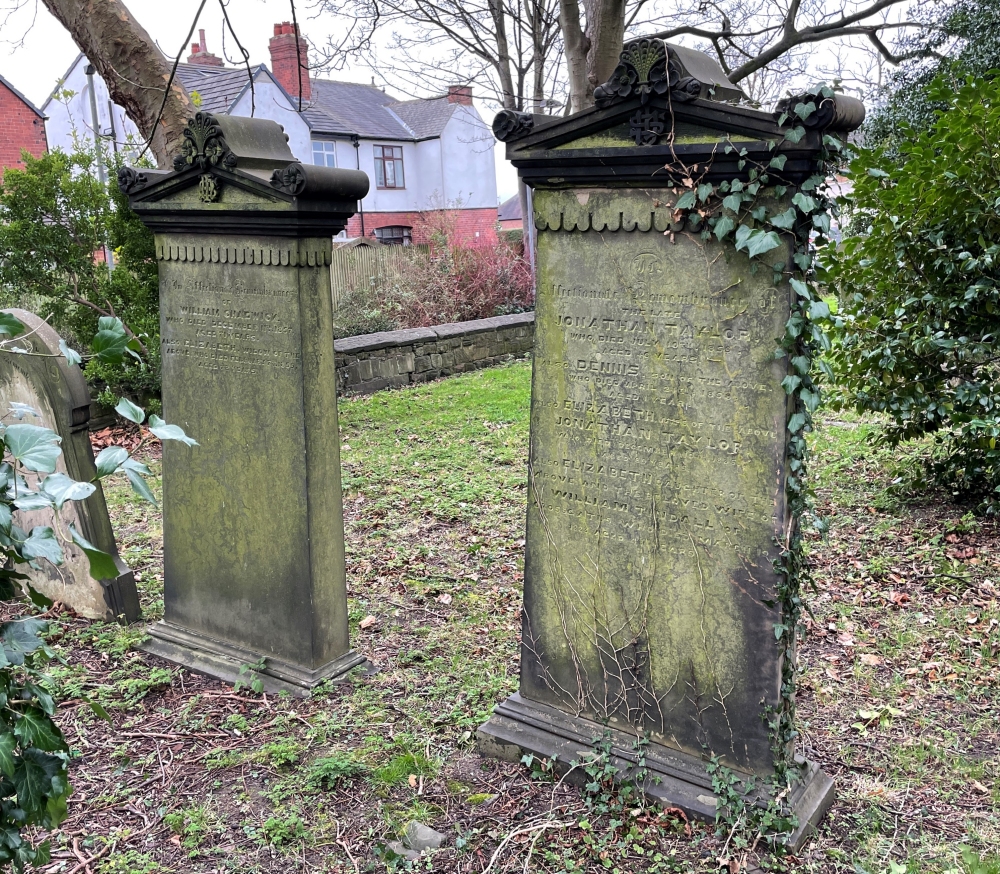 Gravestones of the builder of the "old" Travellers Rest, William Chadwick and his daughter Elizabeth Taylor in Manston St. James Churchyard (photographed : February 2022). Sometime in the mid-1860s Betty opened a beerhouse on the premises calling it "The Travellers Inn", there was no other drinking establishment in Cross Gates at this time. In the 1850s Richard (Dick) Stringer, a coal miner, had run a beerhouse called "The Jolly Colliers" in his house in the part of Cross Gates in Whitkirk parish (the west side of Station Road and all the Cross Gates Lane area) but this has closed by 1861. Beerhouses had been created in 1830 under the Beerhouse Act of Parliament. This was in part passed to break the stranglehold some breweries had over public houses and to reduce the drinking of strong spirits. Beer at the time was seen as a safe, wholesome drink, especially when compared to the quality of some of the drinking water available. A householder simply had to pay two guineas (£2.10) a year for a licence. Initially the beer was sold in a wooden shed in the yard at the back of the grocers shop but as the business increased Betty Taylor transferred it into the shop at the western end of the brick built row. The grocers shop moved to the eastern end. 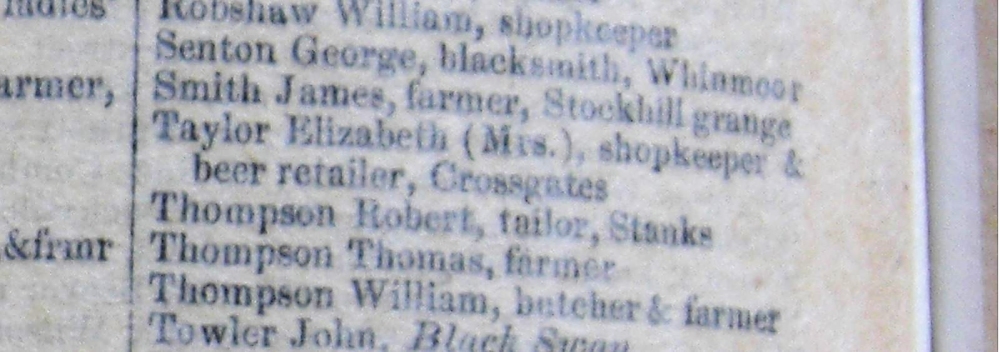 Kellys Directory of the West Riding of Yorkshire - 1867. The first reference to the beerhouse is from the 26th September 1866 when it was alleged that Thomas Eastwood, a labourer from Cross Gates, had a purse containing 2 shillings and a knife stolen from him whilst in the house through "hocussing" (drugging). Thomas had gone to the beerhouse for his dinner and had also ordered a quart of ale. The accused, Edward Brown, Job Goldthorpe, James Mallinson and Joseph Fawcett, all labourers from Wakefield, were also at the beerhouse and struck up a conversation with Eastwood. Fawcett then asked him to taste his beer and shortly afterward he became insensible and remained in that condition until late in the evening. Mr. Pogson, a doctor from Seacroft, was called who initially thought he was drunk but soon found he was under the influence of a power narcotic. It was then discovered that his purse and knife were missing. These were found in the soil adjoining the beerhouses privy and the men were apprehended, Goldthorpe and Mallinson accused the other two of been the thieves. At the subsequent trial held at the Leeds Quarter Sessions on the 15th October 1866 all 4 were found not guilty and it was ordered to be struck from the record, it is unclear from the surviving records why. Subsequent research has shown that at least 3 of the accused led lives of crime and were in and out of prison over the following decades. In August 1872 Betty Taylor applied for a wine licence which was granted meaning beer and wine could be served. Five years later in August 1877 she applied for a full Publican licence meaning spirits could be served. In support of the application, it was stated the house was located close to the railway station at Cross Gates at which the North-Eastern Railway had recently constructed a branch line to Wetherby and it would be a great convenience to travellers waiting for trains. Also, there had been no complaints about the house in 15 years and the house was ¾ of a mile from any other fully licenced premises. The application was supported by a note from the Station Master as well as a petition signed by several influential gentlemen. The application was refused! A rather comical incident recorded to have taken place in January 1880 perhaps provides warning of the mixing of drink and business transactions! John Lumb, a carter of Cross Gates, and William Wright, a market gardener of Manston, were drinking in the Travellers Inn when they agreed to swap horses. Next morning John Lumb woke up with a very sore head and a found a horse called Kildale in his stable, a very lame and poor horse. Wright refused to take the horse back. At a subsequent Court case it was remarked by one of the solicitors "that it was the most disgraceful and drunken case in which he had ever appeared". The jury found for Lumb who was awarded £30 damages. By 1881 the Travellers Inn was being run by 39-year-old William Tindall who was Betty Taylor's son-in-law, the husband of her daughter Elizabeth. The 64-year-old Betty continued to run the grocers' shop and off sales of beer. 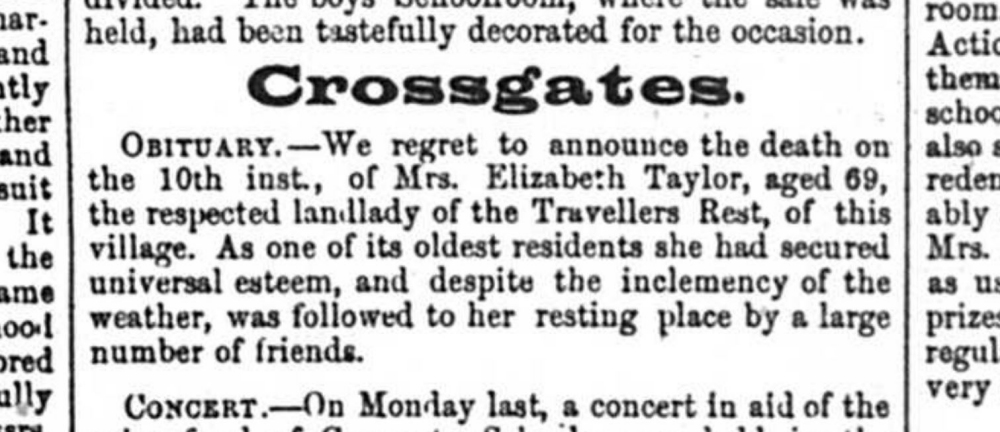 Roundhay Gazette Newspaper - 18th December 1886. Betty Taylor died aged 69 on the 10th December 1886 and was buried at Manston. In her will she left the beerhouse and grocers business to her son-in-law William Tindall. He tried in August 1889 to obtain a full licence for the house and again failed, the Magistrate being of the opinion there were no necessity for it. 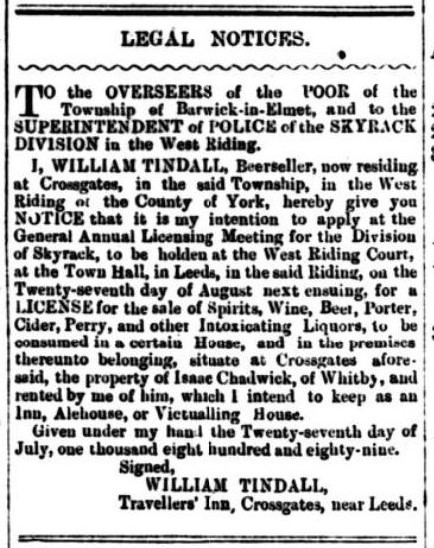 Skyrack Courier Newspaper - 3rd August 1889 - William Tindall applies for a spirits licence - and fails again! Ownership of the building and land had passed to Isaac Chadwick in 1861 and was under Manorial copyhold tenure in the Manor of Barwick and Scholes. On the 10th March 1890 Isaac agreed with the Lord and Lady of the Manor, Frederick Charles Trench-Gascoigne and his wife Mary Isabella, of Parlington Hall, for the payment of £230, to enfranchise the land and it was converted to freehold tenure and freed from all Manorial restrictions and costs. Fifteen days later on the 25th March 1890 Isaac, now of Whitby, sold or transferred the property to his son Caleb Backhouse Chadwick of the City of York, who like his father worked in the coal business. The following year, on the 2nd January 1891, Caleb sold the premises to the brewery owning family of Riley-Smith of Tadcaster trading under the name "John Smiths". William Tindall continued as beerhouse manager for 12 months, but the Riley-Smith's then completed a major refurbishment which likely included the addition of bay windows at the front, the rendering of premises, construction of an ornate porch and internal alterations. It also became known as "The Travellers' Rest" around this time. Whilst officially the house was called "The Travellers' Rest" it was known to many locals as "The Vent Peg". A vent-peg is a stopper or bung, used seal the openings in beer barrels. They can be porous allowing the beer to breathe or condition. The origin of this nickname is currently unknown, it maybe that someone connected with the Travellers invented an improved version of the vent-peg. However, despite extensive research, confirming the nickname from at least 1888, nothing conclusive has been found on the origin of the name. 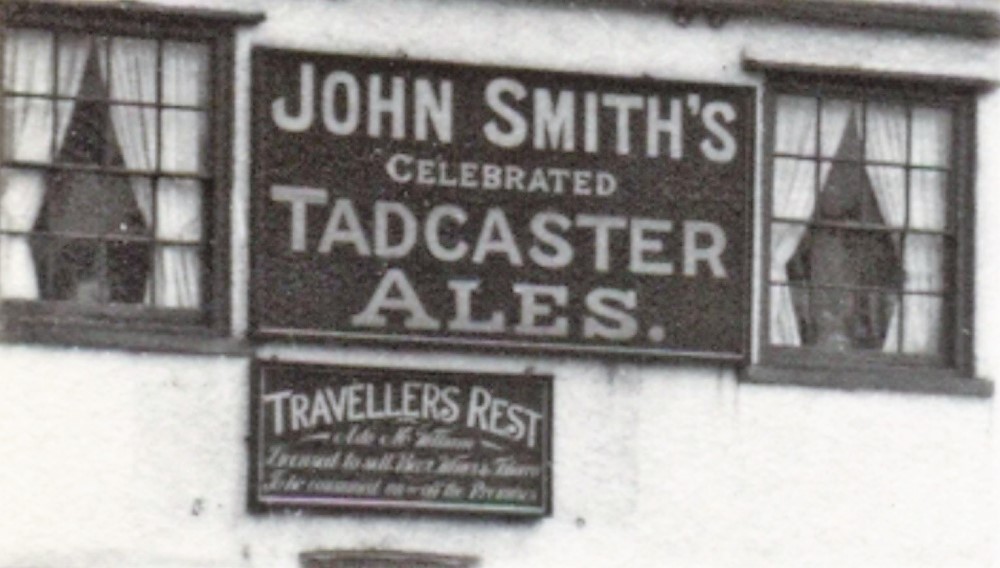 A John Smith's House from 1891 - Station Road end - c1912. A new landlord, John Musgrave Smith, took over on the 5th January 1892. John, who was in his 50s, had previously worked for Messr Riley, cloth merchants in Leeds for over 30 years and lived in Kirkstall where he was a founder member of the Burley Conservative Association and was its first treasurer. When his wife died in 1885 he appears to changed profession and started to manage beerhouses. In August 1892 another application for a full public house licence was presented. John explained to the Magistrate "that improvements had been made in the house and the premises were admirably adapted for the purpose of a full licence". A petition with 160 signatures was also presented. Cross Gates was still without a fully licensed public house at this time. When he was questioned it became clear the owners of the house were the Riley-Smiths of Tadcaster and that he was "tied" to them to supply beer. At the same Court sitting local landowner Darcy Bruce Wilson of Seacroft Hall (who also happened to be a Magistrate on the same Court although he took no part in this element of the proceedings) put forward an application to develop land he owned adjacent to Cross Gates railway station and to build new premises for the sale of all intoxicating liquors. After considering both applications the Magistrates decided to allow Darcy Wilson's application on the condition he gave up a license on another premises he owned. This became the current Station Hotel, Cross Gates, which opened sometime in 1893 or 1894. John M. Smith's application for the Travellers Rest was rejected. 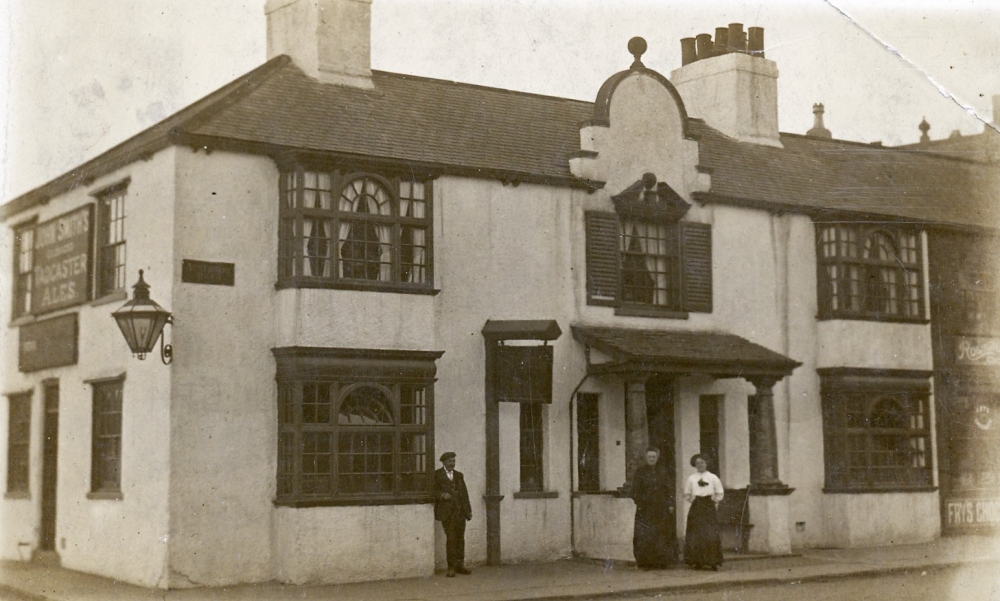 c1905 -An improved house - Austhorpe Road entrance. On Sunday 5th July 1896 at around 10:30 am Henry Robert Ives, a labourer of Armley Road Leeds, was found laid out on the road near the Traveller Rest quite drunk. When discovered by Police Constable Jackson he refused to get up and remarked "there is nothing to look at except gates and green fields!" At the West Riding Magistrates Court in Leeds on Tuesday 14th July 1896 he was asked by the Chairman "Where had you got drunk by this time?" Ives said, "At the Vent Peg Sir" and he explained he was supplied with bread, cheese and beer from 6:30am and had spent over 2 shillings in the house. The Chairman remarked that he must have spent 4 hours in the house and said, "that was your day in the country then?" "Yes" replied Ives. "We fine you 10 shillings including costs!" Relating to this case the landlord, John Musgrave Smith, was hauled in front of the West Riding Magistrate in Leeds on the 21st July 1896 for opening during prohibited hours and permitting drunkenness. In a rather bizarre case the evidence was replayed about a man named Henry Robert Ives who claimed he arrived at the Travellers Rest at 6:30am on Sunday 5th July 1896 and was supplied with 5 pints of beer. A police constable found him at around 10:30 am about 150 yards from the house quite drunk. A witness, John Schofield, a miner, said he worked at the Travellers Rest on Sundays as a waiter and on the morning in question he arrived at 6:55am and the house was all locked up and he had to arouse the landlord's son, William Smith, to let him in. He did not see Ives until 10:00am, drunk, at the entrance to the backyard of the house. He did not serve him and turned him onto the road in the direction of Seacroft. Another miner, George Lovett, said he saw Ives coming from the direction of Leeds at 10:00am heading for the Traveller Rest. The Magistrate said he was quite satisfied that no offence had been committed and they were sorry that Mr Smith had been put to the trouble of coming to Court. He did not believe any of the evidence of Ives (who had 24 previous convictions) and all charges were dismissed, with costs, including the solicitor's fee. Sadly just 5 weeks later, on the 31st August 1896, John Musgrave Smith had a stroke at the beerhouse and died within a few hours. The licence was then taken by John William Briggs and his wife Jane, they came from Morley and had managed the Miners Arms on Albert Road for many years. Jane died in August 1899 and for a while John retired from innkeeping, he remarried and lived at The Laurels in Stanks before returning to Morley as landlord of the White Hart Inn. 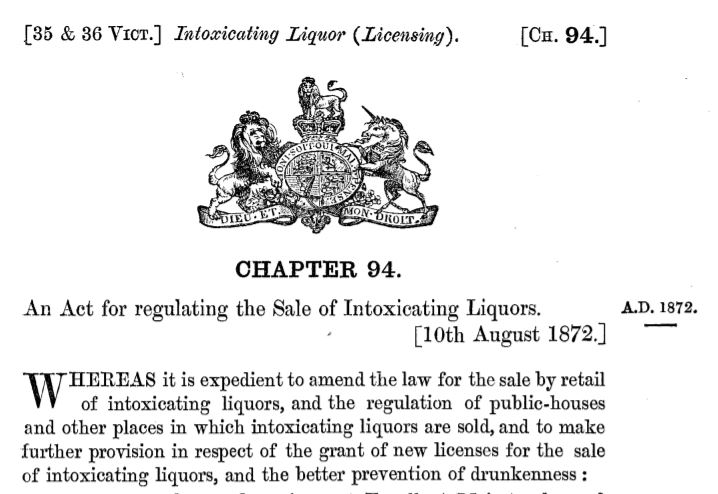 Around the turn of the 20th century there are many newspaper reports of drunken behaviour in Cross Gates, particularly on Sundays. The 1872 Licensing Act had created the infamous so called "bona fide travellers" who could be served outside of normal trading hours. Cross Gates was outside of the Leeds City boundaries but easy to travel to and residents of Leeds flocked to the village, reports are found of horse drawn charabancs of people moving between the districts licenced premises. The residents obviously had had enough as this Parish newsletter article from the late 1890s shows:
|
